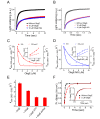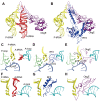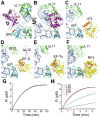Structural and functional insights into the mode of action of a universally conserved Obg GTPase
- PMID: 24844575
- PMCID: PMC4028186
- DOI: 10.1371/journal.pbio.1001866
Structural and functional insights into the mode of action of a universally conserved Obg GTPase
Abstract
Obg proteins are a family of P-loop GTPases, conserved from bacteria to human. The Obg protein in Escherichia coli (ObgE) has been implicated in many diverse cellular functions, with proposed molecular roles in two global processes, ribosome assembly and stringent response. Here, using pre-steady state fast kinetics we demonstrate that ObgE is an anti-association factor, which prevents ribosomal subunit association and downstream steps in translation by binding to the 50S subunit. ObgE is a ribosome dependent GTPase; however, upon binding to guanosine tetraphosphate (ppGpp), the global regulator of stringent response, ObgE exhibits an enhanced interaction with the 50S subunit, resulting in increased equilibrium dissociation of the 70S ribosome into subunits. Furthermore, our cryo-electron microscopy (cryo-EM) structure of the 50S·ObgE·GMPPNP complex indicates that the evolutionarily conserved N-terminal domain (NTD) of ObgE is a tRNA structural mimic, with specific interactions with peptidyl-transferase center, displaying a marked resemblance to Class I release factors. These structural data might define ObgE as a specialized translation factor related to stress responses, and provide a framework towards future elucidation of functional interplay between ObgE and ribosome-associated (p)ppGpp regulators. Together with published data, our results suggest that ObgE might act as a checkpoint in final stages of the 50S subunit assembly under normal growth conditions. And more importantly, ObgE, as a (p)ppGpp effector, might also have a regulatory role in the production of the 50S subunit and its participation in translation under certain stressed conditions. Thus, our findings might have uncovered an under-recognized mechanism of translation control by environmental cues.
Conflict of interest statement
The authors have declared that no competing interests exist.
Figures








Comment in
-
Braking bad: stopping translation in hard times.PLoS Biol. 2014 May 20;12(5):e1001867. doi: 10.1371/journal.pbio.1001867. eCollection 2014 May. PLoS Biol. 2014. PMID: 24844695 Free PMC article. No abstract available.
Similar articles
-
Coexpression of Escherichia coli obgE, Encoding the Evolutionarily Conserved Obg GTPase, with Ribosomal Proteins L21 and L27.J Bacteriol. 2016 Jun 13;198(13):1857-1867. doi: 10.1128/JB.00159-16. Print 2016 Jul 1. J Bacteriol. 2016. PMID: 27137500 Free PMC article.
-
The ObgE/CgtA GTPase influences the stringent response to amino acid starvation in Escherichia coli.Mol Microbiol. 2009 Jul;73(2):253-66. doi: 10.1111/j.1365-2958.2009.06767.x. Epub 2009 Jun 23. Mol Microbiol. 2009. PMID: 19555460 Free PMC article.
-
Structural and biochemical analysis of Escherichia coli ObgE, a central regulator of bacterial persistence.J Biol Chem. 2017 Apr 7;292(14):5871-5883. doi: 10.1074/jbc.M116.761809. Epub 2017 Feb 21. J Biol Chem. 2017. PMID: 28223358 Free PMC article.
-
The structure-function analysis of Obg-like GTPase proteins along the evolutionary tree from bacteria to humans.Genes Cells. 2022 Jul;27(7):469-481. doi: 10.1111/gtc.12942. Epub 2022 May 24. Genes Cells. 2022. PMID: 35610748 Free PMC article. Review.
-
The Impact of the Stringent Response on TRAFAC GTPases and Prokaryotic Ribosome Assembly.Cells. 2019 Oct 24;8(11):1313. doi: 10.3390/cells8111313. Cells. 2019. PMID: 31653044 Free PMC article. Review.
Cited by
-
Global discovery of bacterial RNA-binding proteins by RNase-sensitive gradient profiles reports a new FinO domain protein.RNA. 2020 Oct;26(10):1448-1463. doi: 10.1261/rna.076992.120. Epub 2020 Jul 9. RNA. 2020. PMID: 32646969 Free PMC article.
-
Make and break the alarmone: regulation of (p)ppGpp synthetase/hydrolase enzymes in bacteria.FEMS Microbiol Rev. 2019 Jul 1;43(4):389-400. doi: 10.1093/femsre/fuz009. FEMS Microbiol Rev. 2019. PMID: 30980074 Free PMC article. Review.
-
Linking glucose metabolism to the stringent response through the PTS.Proc Natl Acad Sci U S A. 2018 Jul 17;115(29):7454-7455. doi: 10.1073/pnas.1809265115. Epub 2018 Jul 3. Proc Natl Acad Sci U S A. 2018. PMID: 29970419 Free PMC article. No abstract available.
-
Complementation of the Mycoplasma synoviae MS-H vaccine strain with wild-type obg influencing its growth characteristics.PLoS One. 2018 Mar 28;13(3):e0194528. doi: 10.1371/journal.pone.0194528. eCollection 2018. PLoS One. 2018. PMID: 29590172 Free PMC article.
-
Role of the sarcin-ricin loop of 23S rRNA in biogenesis of the 50S ribosomal subunit.RNA. 2025 Mar 18;31(4):585-599. doi: 10.1261/rna.080335.124. RNA. 2025. PMID: 39875174 Free PMC article.
References
-
- Wittinghofer A, Vetter IR (2011) Structure-function relationships of the G domain, a canonical switch motif. Annu Rev Biochem 80: 943–971. - PubMed
-
- Kint C, Verstraeten N, Hofkens J, Fauvart M, Michiels J (2013) Bacterial Obg proteins: GTPases at the nexus of protein and DNA synthesis. Crit Rev Microbiol. - PubMed
Publication types
MeSH terms
Substances
LinkOut - more resources
Full Text Sources
Other Literature Sources
Molecular Biology Databases

